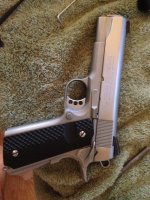Catchabullet
New member
Hi,
I have recently detailed cleaned my series 80 Colt Commander (with Ed Brown parts, so... not stock, I feel that is important information) and if the trigger is depressed all the way down (to feel reset upon letting off), it will not allow me to pull the slide back with it depressed all the way. I have to let off a tiny bit for it to allow me to pull the slide rearward.
I figured, "Hey, maybe i assembly it incorrectly." so took it apart and found everything in the right place (series 80 parts were a concern.). Would the overtravel screw need adjustment to fix this problem? Someone please explain....
Thanks in advance for your help.
I have recently detailed cleaned my series 80 Colt Commander (with Ed Brown parts, so... not stock, I feel that is important information) and if the trigger is depressed all the way down (to feel reset upon letting off), it will not allow me to pull the slide back with it depressed all the way. I have to let off a tiny bit for it to allow me to pull the slide rearward.
I figured, "Hey, maybe i assembly it incorrectly." so took it apart and found everything in the right place (series 80 parts were a concern.). Would the overtravel screw need adjustment to fix this problem? Someone please explain....
Thanks in advance for your help.

